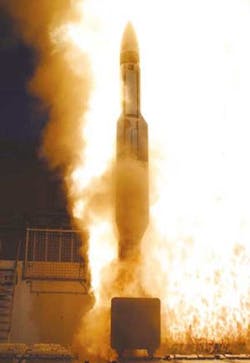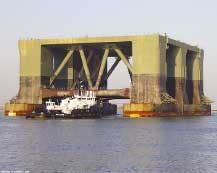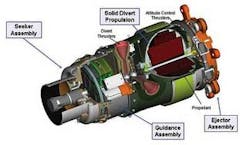Ballistic missile defense looks to the future
As missile defense technologies enter the 21st century, scientists and engineers build on projects begun decades ago, as well as draw from the latest off-the-shelf products to craft a reliable and layered system to defend the U.S. its allies from missile attack
By J.R. Wilson
When President Ronald Reagan first proposed creation of a "shield" to protect the United States from nuclear-tipped missile attack, critics labeled his Strategic Defense Initiative (SDI) as "Star Wars" — SDI opponents denounced it as a pipedream. It would be impossible, critics contended, to intercept all of the thousands of missiles the Soviet Union would launch in an all-out exchange. While SDI was funded during Reagan's presidency, support fell rapidly under his successors.
By the time George W. Bush took office 12 years later, the Soviet Union was gone and Russia was working with the United States to dismantle the intercontinental and intermediate-range ballistic missiles (ICBMs and IRBMs) that had been the foundation of the Cold War strategy of Mutual Assured Destruction (MAD). As a result, SDI had all but vanished from the government's priority list. The last budget proposal from the Clinton Administration requested $4.5 billion for missile defense, although Congress approved $4.8 billion.
A revival began the following year, when President Bush requested $8.3 billion and Congress approved $7.8 billion. Both quickly escalated, however, with Congress approving the President's $9.1 billion request for 2004; action on his $10 billion-plus request for 2005 is pending, but administration officials have indicated they plan to spend more than $55 billion to further develop and begin deployment of missile defenses through the end of this decade.
Growing missile proliferation
The increased spending stemmed from the growing proliferation of nuclear and long-range missile programs and capability — especially among nations that have threatened their use against the U.S. and its allies or that might provide such capability to Al Qaeda or other terrorist organizations. In 2002, President Bush ordered a restructuring and reinvigoration of ballistic missile defense efforts, and Defense Secretary Donald Rumsfeld complied by creating the Missile Defense Agency (MDA) to take over research begun or expanded under SDI — but with a new approach more specific to changing world realities.
The new threat differs fundamentally from the old Cold War threat. It does not require defense against thousands of nuclear warheads coming over the North Pole. Instead, it must deal with a handful of missiles coming from virtually any direction and armed not only with nuclear warheads but also with chemical or biological agents. At least 25 countries now possess — or are working hard to acquire — nuclear, biological, or chemical (NBC) weapons. A true defense also requires new, multiple-opportunity approaches to increase the likelihood of preventing any attack from reaching any part of the United States, its territories, or its allies.
In congressional budget testimony in March, Lt. Gen. Ronald Kadish, director of the new MDA, emphasized the importance of this evolution in BMD concepts.
"Ballistic missile defense–system layered defenses help reduce the chances that any hostile missile will get through to its target," he told the Senate Armed Services Committee. "They give us better protection by enabling engagements in all phases of a missile's flight and make it possible to have a high degree of confidence in the performance of the missile defense system. The reliability, synergy, and effectiveness of the BMD system can be improved by fielding overlapping, complementary capabilities."
While SDI had looked at surface- and space-based launch detection and interception, MDA is investigating a wide range of ways to hit a detected launch at all phases of flight. Among those are:
- Airborne Laser;
- Ground-Based Midcourse Defense;
- Medium Extended Air Defense System;
- Patriot Advanced Capability-3;
- Aegis BMD;
- Sea-Based X-Band Radar;
- Space Tracking and Surveillance System;
- Terminal High Altitude Area Defense;
- Project Hercules;
- Passive and Active Sensor Technology;
- Airship Enabling Technologies;
- Airborne Infrared Sensor;
- Space-Based Passive Surveillance;
- Radar System Technology; and
- Multiple Kill Vehicle.
Program details
The Airborne Laser (ABL) would bring together several technologies aboard a converted Boeing 747-400 jet freighter. The system is designed to detect, track, target, and kill all classes of enemy missiles — short-, medium-, or long-range — with the world's first laser weapon.
IR sensors at the front, rear, and sides of the aircraft detect the launch and location. Then one of the system's four lasers locks on and tracks the missile, a second determines the best aim point on the target, and a third measures levels of atmospheric disturbance between the ABL and its target, enabling onboard computers and adaptive mirrors to compensate for beam refraction.
That done, a megawatt-class chemical oxygen iodine laser, or COIL, fires to heat the target missile's pressurized hull until it cracks and the fuel explodes. Initial delivery of a contingent capability has been delayed from Block 2004 to Block 2006.
The Ground-Based Midcourse Defense (GMD) would act during the missile's mid-course flight, which can last as long as 20 minutes. In this phase of flight an attacking missile is essentially coasting toward its target at speeds exceeding 15,000 miles per hour. At the end of 2002, President Bush ordered MDA to field as many as 10 GMD interceptors by the end of 2004 and an additional 10 by 2005, along with their support components.
The Medium Extended Air Defense System (MEADS) is a cooperative effort of the United States, Germany, and Italy, and is intended to counter ballistic missiles and threats from aircraft, unmanned aerial vehicles (UAVs), and cruise missiles, bridging the gap between higher-level ballistic missile systems and man-portable weapons such as the Stinger missile.
The Patriot Advanced Capability-3 (PAC-3) is a descendant of the Patriot missiles used to defend against SCUD attacks during the first Persian Gulf War of 1991. PAC-3 is perhaps the most mature BMD effort. As such, it was transferred from MDA to the U.S. Army in April 2003 for further development, production, and fielding, which already has begun.
The Aegis BMD uses the Navy's Aegis destroyers, and currently provides long-range surveillance and tracking (LRS&T) sensor capability for GMD; in 2004–2006, it is to add hit-to-kill capability against short- and medium-range ballistic missiles; beyond 2006, through technology insertion, that will expand to include interception and destruction of IRBMs.
The Sea-Based X-Band Radar (SBX) is a unique combination of advanced X-band radar and a state-of-the-art semisubmersible ocean-going platform. SBX will provide tracking and discrimination of incoming missiles for GMD. Based on a fifth-generation relocatable oil-drilling platform, it is to be fully operational by the end of 2005, providing a repositionable, forward-based capability to deal with evolving missile threats.
The Space Tracking and Surveillance System (STSS) was restructured in 2002 from the former SBIRS-Low (Space Based Infrared Surveillance) program. STSS will use a series of interoperable low-Earth orbit (LEO) satellites for global detection and tracking of ballistic missiles, separating warheads from decoys, and enhancing early interception capability.
One of the most recognizable BMD programs, the Terminal High Altitude Area Defense (THAAD) is designed to destroy incoming short- and medium-range ballistic missiles at the transition from mid-course to terminal flight — inside and just outside the Earth's atmosphere.
The land-based THAAD is to provide a rapidly mobile final layer of missile defense for U.S. and allied troops and territories. Of its four primary components — truck-mounted launchers, interceptors, and radars, as well as command, control, and battle-management (C2BM) systems — all but some radar systems are transportable by C-130 aircraft. THAAD's strategy of two-year development blocks (2004–2008) is to get elements into the field as quickly and affordably as possible.
MDA officials say they hope several advanced programs that are also using two-year block–based development will further the evolution of BMDS algorithms for discrimination, sensor fusion, and battle management.
Advanced technology
The first of these programs is Project Hercules, which is to develop robust, adaptive computer algorithms to counter the evolving global missile threat, including advances that may have eluded intelligence gathering. That also include using advanced decision theory to develop future C2BM concepts.
Next is Passive and Active Sensor Technology, which is intended to advance and ensure early launch detection and tracking (ELDT) throughout the BMDS architecture through advances in all-weather, large standoff range, wide-area surveillance, prompt response, low false alarms, target classification, and direct link to shooter. Accomplishing those entails advancing such technologies as optoelectronics, infrared, as well as active and passive radio-frequency (RF) sensors to enhance ABL and Kinetic Energy Boost Phase Intercept effectiveness.
The next project is Airship Enabling Technologies. As part of one of the most advanced technology efforts in history, MDA is also looking to one of the oldest technologies in flight — the blimp. While also being considered for a variety of other applications, the High Altitude Airship (HAA) program is under MDA direction for its potential to provide long-duration wide-area surveillance and communications for BMDS. The ongoing HAA Advanced Concept Technology Demonstration (ACTD) is assessing capability, feasibility, costs, and risk for inclusion in the BMDS Block 2006 test bed.
The Airborne Infrared Sensor (AIRS) aims at advancing airborne IR-surveillance and fire-control functions, using existing test and evaluation assets, and serving as a contingency capability for the BMDS test bed.
The Space-Based Passive Surveillance (SBPS) program seeks to advance technologies for focal-plane arrays, optical elements, cryocoolers, and radiation-hardened electronics to enhance the performance of MDA's Space Tracking Surveillance Satellites System (STSS).
Meanwhile, the Radar System Technology (RST) program is to develop the enabling technologies required for dramatic enhancements in performance and survivability, then integrate resulting radar-system upgrades into BMDS. This differs from historical programs in which any advance in one military technology was quickly countered by advances in countermeasures. A joint effort by MDA, the Air Force Research Lab (AFRL), Office of Naval Research (ONR), Defense Advanced Research Projects Agency (DARPA) and industry, RST research includes improvements in radar sensitivity and discrimination, transportability of smaller and less-expensive antenna configurations, countermeasure mitigation, and lifecycle cost reductions.
Finally, the Multiple Kill Vehicle (MKV) program is managed by MDA and executed by the Army Space and Missile Defense Technical Center in Huntsville, Ala. MKV involves integrating multiple small kill vehicles onto a single launch vehicle.
"Our national intelligence estimates continue to warn that in coming years we will face ballistic missile threats from a variety of actors," Kadish told the House Armed Services subcommittee on strategic forces. "The recent events surrounding Libya's admission concerning its ballistic-missile and weapons-of-mass-destruction programs remind us that we are vulnerable. Ballistic missiles armed with any type warhead would give our adversaries the capability to threaten or inflict catastrophic damage.
"Layered defenses help reduce the chances that any hostile missile will get through to its target," Kadish continued. "They give us better protection by enabling engagements in all phases of a missile's flight and make it possible to have a high degree of confidence in the performance of the missile defense system. The reliability, synergy, and effectiveness of the BMD system can be improved by fielding overlapping, complementary capabilities. In other words, the ability to hit a missile in boost, mid-course, or terminal phase of flight enhances system performance against an operationally challenging threat."
The role of industry
The rapid turnaround in spending and program demands has kept the companies in the defense industry scrambling for a place at the table and new ways to use or enhance their core technologies to meet the challenge.
Among those is Raytheon, one of the few surviving U.S. aerospace and defense giants. Its Integrated Defense Systems component in Tewksbury, Mass., for example, has been working on how to fuse its long history and knowledge of electro-optical/infrared (EO/IR) and discrimination radar into the evolving MDA regime of layered platforms.
"When you can fuse EO with a different phenomenology, such as a precise X-band radar, it greatly enhances your ability to look at decoys and countermeasures and pick out the warhead from those clusters," Peter Franklin, vice president for Raytheon's missile defense strategic business area, notes, adding several technologies now being investigated were initiated under SDI. "A lot of what we're doing now is carrying on the excellent work that went before — but looking at things in different ways than before."
"Take X-band radar — sea-based will be fielded in 2005, the THAAD radar that just rolled out, the BMDS radar, which can be positioned forward or wherever appropriate — all of these were in development in the early '80s, when we were trying to prove we could have a high-frequency X-band radar for tracking and discrimination," Franklin says. "The SM3 projectile in the Standard Missile 3 is based on LEAP (lightweight exoatmospheric projectile) technology developed in the 1980s for SDIO. Much of the longwave-IR technology necessary for the acquisition and tracking of very cold objects in space serves as a basis for many of our EO/IR seekers."
While many of the technologies developed for SDI two decades ago are finding new life in the revived MDA effort, considerable work remains to be done on engineering reliability, cost reduction, integration — especially for IR seekers in space — and how to accelerate lightweight projectiles to sufficiently high speeds from orbit to provide a kinetic-energy (KE) kill against an enemy missile during boost phase.
Another lesson from that past effort is the need to enforce absolute requirements for open architecture — hardware and software — to facilitate the inevitable technology insertion needed down the line to keep the system ahead of whatever countermeasures may evolve.
"I've never seen anyone who had enough processing power," Franklin says. "One thing we are trying hard to ensure is that we have an open architecture that won't lock us into a dead-end processor and, if it changes, we won't have to redo the architecture to accommodate a newer, better processor."
The resurrection of 1980s developments has not curtailed the search for new ideas to deal with BMD requirements. Joey Sevin, director for radar business development at Mercury Defense Electronics Group in Chelmsford, Mass. — which is involved in several MDA efforts — believes unorthodox methods may be the key to ensuring persistent ISR (intelligence, surveillance, and reconnaissance).
"If an asset is flying, it should have a sensor on it, even if it is a tanker up there to refuel F-15s, because we need the ability to see everywhere all the time," he says. "ABL's job is to do the actual beam control and fire. There will only be so many ABLs if they go to production because they are so large and costly, so you would need a large number of less expensive platforms to keep watch and alert 24/7 if anything happens. It would be advantageous and important to have this as a node on the network for MDA or homeland security."
Military system needs
However innovative or advanced the platforms used for detection, tracking, or destruction of incoming missiles, among the most important factors for MDA are the eternal standards for all military programs: weight, size, cost, speed, and power.
"If you go back to the concept of airborne collection platforms, those are getting smaller, but they still want all the sensors onboard," Sevin says. As a result, everything from the future Joint Surveillance Target Attack Radar System (Joint STARS) to small platforms will need more sensors, which means more processing, "which means more gigaFLOPS per cubic foot," Sevin says. "They also want to do processing closer to the sensor, because with multiple sensors on one platform, you have the opportunity for sensor fusion. And if you go offboard for processing, you have the problems of a reliable high-speed datalink. You can save on those datalink requirements by doing the initial processing onboard, then sending down only what is of interest.
"It would be nice if all technologies evolved at the same time, but they don't, which causes all of us a lot of problems with clock speed. So I don't see any one being the gating factor — all have to be aligned to provide a balanced system. Why have a 2-GHz processor if you can't feed it or if the datalink is too slow?"
Leaders of each of the military services are addressing these issues for their own BMD-related platforms, while also dealing with compatibility and interoperability requirements.
For example, the Navy's future family of land-attack destroyers, called the DD(X), is the centerpiece of a group of surface combatant ships designed to deliver a vast range of war-fighting capabilities, including ballistic missile defense. As the Navy's first fully open-architecture program, however, DD(X) also is the first to follow new guidelines on interoperability, says Theresa Rickman, military and aerospace programs manager for LynuxWorks in San Jose, Calif.
"Navy open architecture will impact every major Navy system in the future, all of which have missile defense as a major subsystem," she says. "The PEO-Integrated Warfare Systems has said all systems must be portable and interoperable, for cost and time-to-deployment reasons."
While the other services are working toward the same goal, so far only the Navy has created an enforcement mechanism and has given the standards body program office authority over the prime contractors. As a result of enforcing a standard portable operating system interface (POSIX), Rickman says, "There is no reason you can't turn an off-the-shelf PC into a hardened real-time system at a fraction of the cost of a dedicated special system. So you can do missile tracking at a tenth the cost of what they used to build them for, if not a hundredth."
Dr. Inder Singh, the LynuxWorks CEO, says the Navy chose the LynuxWorks LynxOS real-time operating system for all Navy embedded and distributed applications programs because it was the only one certified IEEE POSIX conformant.
"Linux is totally deterministic; the engineer writing the software can determine exactly when something will happen," he explains. "It is the only system that combines the technical requirements for hardware performance and is based on open standards. So you can take any existing Linux or Unix software and use it in this environment.
"Today everything talks to everything else, not just a lot of black boxes on the battlefield. If everything is built by different contractors using different software and operating systems, it becomes very difficult to coordinate. In the past, hardware real-time systems were very proprietary. If you are building a large battlefield system that has standard computers and an integrated software system, this is the best way to have it be cost-effective and ready on time. It is a very key enabling technology."
The block development process used for many missile-defense components has been crucial to new technology insertion and spiral fielding of advanced components, often years before the final configuration is ready for the battlefield.
"This isn't like building a tank, where you can predict who and where the enemy is likely to be and what threat they will pose," Raytheon's Franklin says. "You must have enough flexibility to hit in all phases. So if a new adversary comes along, we will put enough doubt into his mind about being able to successfully put a missile into the U.S. that he won't try."
Something else has changed since SDI was first proposed — the federal government, largely in the form of NASA and the U.S. Department of Defense (DOD), is no longer the primary technology driver. Today, worldwide, the highly competitive commercial marketplace is driving processor speed, alternative power sources, lightweight, high-strength materials — and fully open architectures for BMD.
"Even at the platform level, we are trying to keep the architecture open almost to the point of plug-and-play so we can take advantage of new technologies and use them when they are mature enough to be used," Franklin says. "There are a lot of technologies — IR, radar, etc. — that could push the state-of-the-art of these components, make them smaller, lighter, much faster than what we now have. And the processing can enable us to network them much better.
"One constraint on our thinking in the 1980s was one large system to protect the U.S. from fixed places. When we removed that constraint, we came up with a lot of things we had not thought of before. Those may come from other agencies or other programs unrelated to this. So while it is hard to say what the future eurekas may be, I can certainly say there will be future eurekas. The key is to make the system sufficiently flexible to adapt those."
MDA Director Kadish says President Bush, in directing MDA scientists to field whatever they develop as soon as the development has a use, then improve on it, has "codified in national policy the principle of evolutionary, capability-based acquisition and applied it to missile defense", while building on the 1999 National Missile Defense Act, which calls for deployment "as soon as technologically possible."
"The fact is that ballistic missile defense has proven itself technologically possible. Not only have most of the well-publicized flight tests been successful, but so have the equally important computer simulations and software tests," he says. "Those tests and upgrades will continue for a long time to come — long after the system is fielded and long after it is deemed operational. After all, this is the heart of evolutionary, capability-based acquisition. This is not a concept designed to trick or mislead. It is simply the logical response to the following question: Defenseless in the face of unpredictable threats, which would we rather have — some capability today or none as we seek a 100 percent solution?"
Ballistic missile defense glossary
ABL — Airborne Laser
ACTD — Advanced Concept Technology Demonstration
AFRL — Air Force Research Lab
AIRS — Airborne Infrared Sensor
C2BM — command, control, and battle-management
DARPA — Defense Advanced Research Projects Agency
DOD — U.S. Department of Defense
ELDT — early launch detection and tracking
EO/IR — electro-optical/infrared
GMD — Ground-Based Midcourse Defense
HAA — High Altitude Airship
ICBMs — intercontinental ballistic missiles
IRBMs — intermediate-range ballistic missiles
ISR — intelligence, surveillance and reconnaissance
Joint STARS — Joint Surveillance Target Attack Radar System
KE — kinetic energy
LEAP — lightweight exoatmospheric projectile
LEO — low-Earth orbit
LRS&T — long-range surveillance and tracking sensor
MAD — Mutually Assured Destruction
MDA — Missile Defense Agency
MEADS — Medium Extended Air Defense System
MKV — Multiple Kill Vehicle
NBC — nuclear, biological, or chemical weapons
ONR — Office of Naval Research
PAC-3 — Patriot Advanced Capability-3
PEO — program executive officer
POSIX — portable operating system interface
RF — radio frequency
RST — Radar System Technology
SBIRS-Low — The low-orbit Space Based Infrared Surveillance program
SBPS — Space-Based Passive Surveillance
SBX — Sea-Based X-Band Radar
SDI — Strategic Defense Initiative
STSS — Space Tracking Surveillance Satellites system
THAAD — Terminal High Altitude Area Defense
UAVs — unmanned aerial vehicles





